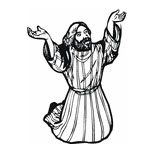
Prayer Postures: What They Mean & Why They Matter
ISLAMIC SALAT & CATHOLIC ADORATION
Saint John Damascene (d. 749) was the first major Christian theologian to defend the faith against Islam. He did so by describing the power of the incarnation, whose energy lies at the heart of the world. The mystery of the incarnation and the sacramental life it offers distinguish Christianity from religions of pure immanence or pure transcendence, which focus solely on one aspect of the divine to the neglect of the full truth. In keeping with Prosper of Aquitaine’s ancient dictum lex orandi, lex credendi (“as we pray, so we believe”), and in light of the revival of Islamic influence in the West, it is paramount to explore the historical, theological, and pastoral considerations implicit in the body language of Catholic and Islamic adoration.
In Islamic worship, adoration in the act of prostration — bending the knees to a sitting position and resting the palms and forehead on the ground in a single action — expresses the worshiper’s humility and sense of utter insignificance before God, and forms the central, repetitive part of the daily salat (prayer). This self-effacing, enclosed posture stresses the distance between the human and the divine.
In Catholic worship, kneeling is the prescribed posture for public eucharistic adoration. Pope John Paul II taught that eucharistic worship is the focal point of Catholic life, and adoration of Christ in the Eucharist forms the basis by which we are disposed to be witnesses of Christ in the world.
Clearly, these prayer postures stem from diverse interpretations of the divine presence in the theologies of Catholic and Muslim adoration. For Catholics, eucharistic adoration is the pivot on which authentic mysticism turns because it joins the transcendence of God’s power to the immanence of divine love. God incarnate is manifest and made present in the paradox — indeed, in the scandal — of sacramental particularity. Muslims, however, reject the incarnation. Allah is not understood as “Father,” nor is he present sacramentally. As an affirmation of divine transcendence that avoids the specter of idolatry (shirk), the Muslim is forbidden from casting his eyes on any created thing while performing the ritual salat.
You May Also Enjoy
The CDW cardinal's letter affirms that it is "completely appropriate" to kneel to receive Communion. Kneeling is not forbidden. No priest or bishop can force us to stand.
To all the people not theologically schooled, a definite message has been communicated about the meaning (or lack thereof) of the Eucharist.
The Church seems to choose to appear as in decline artistically, liturgically, and inspirationally.

